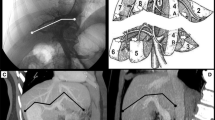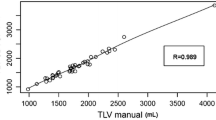Abstract
Background
The novel technique of virtual hepatectomy is useful for evaluation of the portal territory of the liver, since this software program includes functions for liver surgery planning. We evaluated the accuracy of virtual hepatectomy for anatomical hepatectomy.
Methods
Between 2010 and 2011, 92 patients with liver tumors underwent virtual hepatectomy preoperatively. The predicted liver volume was compared with the actual liver volume among patients who underwent anatomical sectionectomy, segmentectomy, and hemihepatectomy.
Results
Ninety of 92 patients underwent anatomical hepatectomy on the basis of virtual hepatectomy. According to the surgical procedure, the predicted liver resection volume showed a strong correlation with the actual liver volume in patients who underwent sectionectomy (r = 0.985, p < 0.0001, n = 44, median error rate 9 %), segmentectomy (r = 0.949, p < 0.0001, n = 17, median error rate 12 %), and hemihepatectomy (r = 0.967, p < 0.0001, n = 29, median error rate 7 %).
Conclusions
The novel technique of virtual hepatectomy is useful for evaluation of the portal territory for anatomical sectionectomy, segmentectomy, and hemihepatectomy.



Similar content being viewed by others
References
Yamamoto M, Takasaki K, Otsubo T, Katsuragawa H, Fukuda C, Katagiri S. Effectiveness of systematized hepatectomy with Glisson’s pedicle transection at hepatic hilus for small nodular hepatocellular carcinoma: retrospective analysis. Surgery. 2001;130:443–8.
Hasegawa K, Kokudo N, Imamura H, Matsuyama Y, Aoki T, Minagawa M, et al. Prognostic impact of anatomic resection for hepatocellular carcinoma. Ann Surg. 2005;242:252–9.
Eguchi S, Kanematsu T, Arii S, Okazaki M, Okita K, Omata M, et al. Liver Cancer Study Group of Japan. Comparison of the outcomes between an anatomical subsegmentectomy and a non-anatomical minor hepatectomy for single hepatocellular carcinomas based on a Japanese nationwide survey. Surgery. 2008;143:469–75.
Takasaki K, Kobayashi S, Tanaka S, Saito A, Yamamoto M, Hanyu F. Highly anatomically systematized hepatic resection with Glissonean sheath cord transection at the hepatic hilus. Int Surg. 1990;75:73–7.
Takasaki K. Glissonean pedicle transection method for hepatic resection: a new concept of liver segmentation. J Hepatobiliary Pancreat Surg. 1998;5:286–91.
Makuuchi M, Hasegawa H, Yamazaki S. Ultrasonically guided subsegmentectomy. Surg Gynecol Obstet. 1985;161:346–50.
Lamadé W, Glombitza G, Fischer L, Chiu P, Cárdenas CE Sr, Thorn M, et al. The impact of 3-dimensional reconstructions on operation planning in liver surgery. Arch Surg. 2000;135:1256–61.
Rau HG, Schauer R, Helmberger T, Holzknecht N, von Rückmann B, Meyer L, et al. Impact of virtual reality imaging on hepatic liver tumor resection: calculation of risk. Langenbeck’s Arch Surg. 2000;385:162–70.
Wigmore SJ, Redhead DN, Yan XJ, Casey J, Madhavan K, Dejong CH, et al. Virtual hepatic resection using three-dimensional reconstruction of helical computed tomography angioportograms. Ann Surg. 2000;233:221–6.
Saito S, Yamanaka J, Miura K, Nakao N, Nagao T, Sugimoto T, et al. A novel 3D hepatectomy simulation based on liver circulation: application to liver resection and transplantation. Hepatology. 2005;41:1297–304.
Lang H, Radtke A, Hindennach M, Schroeder T, Frühauf NR, Malagó M, et al. Impact of virtual tumor resection and computer-assisted risk analysis on operation planning and intraoperative strategy in major hepatic resection. Arch Surg. 2005;140:629–38.
Yamanaka J, Saito S, Iimuro Y, Hirano T, Okada T, Kuroda N, et al. The impact of 3-D virtual hepatectomy simulation in living-donor liver transplantation. J Hepatobiliary Pancreat Surg. 2006;13:363–9.
Terminology Committee of the International Hepato-Pancreato-Biliary Association: Modified from the Brisbane 2000 Terminology of liver anatomy and resections. HPB. 2000;2:333–9.
Clavien PA, Barkun J, de Oliveira ML, Vauthey JN, Dindo D, Schulick RD, et al. The Clavien–Dindo classification of surgical complications: five-year experience. Ann Surg. 2009;250:187–96.
Karlo C, Reiner CS, Stolzmann P, Breitenstein S, Marincek B, Weishaupt D, et al. CT- and MRI-based volumetry of resected liver specimen: comparison to intraoperative volume and weight measurements and calculation of conversion factors. Eur J Radiol. 2010;75:107–11.
van der Vorst JR, van Dam RM, van Stiphout RS, van den Broek MA, Hollander IH, Kessels AG, et al. Virtual liver resection and volumetric analysis of the future liver remnant using open source image processing software. World J Surg. 2010;34:2426–33.
Dello SA, Stoot JH, van Stiphout RS, Bloemen JG, Wigmore SJ, Dejong CH, et al. Prospective volumetric assessment of the liver on a personal computer by nonradiologists prior to partial hepatectomy. World J Surg. 2011;35:386–92.
Okamoto E, Kyo A, Yamanaka N, Tanaka N, Kuwata K. Prediction of the safe limits of hepatectomy by combined volumetric and functional measurements in patients with impaired hepatic function. Surgery. 1984;95:586–92.
Takasaki K, Kobayashi S, Suzuki S, Muto H, Marada M, Yamana Y, et al. Predetermining postoperative hepatic function for hepatectomies. Int Surg. 1980;65:309–13.
Ariizumi S, Yamamoto M, Takasaki K. Right hepatectomy for hepatocellular carcinoma in patients with an indocyanine green retention rate at 15 minutes of 10 % or higher. Dig Surg. 2009;26:135–42.
Schindl MJ, Redhead DN, Fearon KC, Garden OJ, Wigmore SJ, Edinburgh Liver Surgery and Transplantation Experimental Research Group (eLISTER). The value of residual liver volume as a predictor of hepatic dysfunction and infection after major liver resection. Gut. 2005;54:289–96.
Kawasaki S, Makuuchi M, Matsunami H, Hashikura Y, Ikegami T, Chisuwa H, et al. Preoperative measurement of segmental liver volume of donors for living related liver transplantation. Hepatology. 1993;18:1115–20.
Sakamoto S, Uemoto S, Uryuhara K, Kim ID, Kiuchi T, Egawa H, et al. Graft size assessment and analysis of donors for living donor liver transplantation using right lobe. Transplantation. 2001;71:1407–13.
Yamanaka J, Saito S, Fujimoto J. Impact of preoperative planning using virtual segmental volumetry on liver resection for hepatocellular carcinoma. World J Surg. 2007;31:1249–55.
Makuuchi M, Hashikura Y, Kawasaki S, Tan D, Kosuge T, Takayama T. Personal experience of right anterior segmentectomy (segments V and VIII) for hepatic malignancies. Surgery. 1993;114:52–8.
Ariizumi S, Katagiri S, Katsuragawa H, Kotera Y, Yamamoto M. Sectionectomy is suitable for patients with T2 hepatocellular carcinoma according to the modified international union against cancer TNM classification. Dig Surg. 2007;24:342–8.
Yamamoto M, Ariizumi S, Katagiri S, Kotera Y, Takahashi Y. The value of anatomical liver sectionectomy for patients with a solitary hepatocellular carcinoma from 2 to 5 cm in greatest diameter. J Surg Oncol. 2009;100:585–8.
Yamamoto M, Katagiri S, Ariizumi S, Kotera Y, Takahashi Y. Glissonean pedicle transection method for liver surgery (with video). J Hepatobiliary Pancreat Sci. 2012;19:3–8.
Acknowledgments
The authors are indebted to Associate Professor Raoul Breugelmans of the Department of International Medical Communications of Tokyo Medical University for his review of this manuscript.
Conflict of interest
The authors declare that they have no conflict of interest.
Author information
Authors and Affiliations
Corresponding author
About this article
Cite this article
Ariizumi, Si., Takahashi, Y., Kotera, Y. et al. Novel virtual hepatectomy is useful for evaluation of the portal territory for anatomical sectionectomy, segmentectomy, and hemihepatectomy. J Hepatobiliary Pancreat Sci 20, 396–402 (2013). https://doi.org/10.1007/s00534-012-0573-z
Published:
Issue Date:
DOI: https://doi.org/10.1007/s00534-012-0573-z




